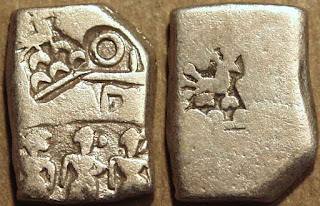Mauryan Empire, perhaps Ashoka the
Great (273-232 BCE), Silver karshapana
Mauryan Empire, perhaps Ashoka the Great (273-232 BCE),
Silver karshapana
Weight: 2.96 gm., Dim: 10 x 15 mm.
Three punches (three deities, peacock on hill,
"steelyard" / Single punch (peacock on hill)
This is a silver karshapana of the Maurya dynasty.
Unfortunately, we do not have a definitive way to attribute these coins to
specific kings, but this coin may well have been an issue of Ashoka the Great.
Most Mauryan coins continued the Magadha pattern of five punches: a sun, a
6-arm symbol, and three others. This coin, however, is a rare deviant from this
general pattern. The sun and 6-arm symbol have been eliminated and there are
only three punches, although one is a compound punch with three figures. (There
are other, similar, coins with three separate figure punches very much like the
three on this single punch.) The punches include a very interesting one of a
peacock perched on a 5-arch hill, which in all probability was a Buddhist
symbol. A smaller version of the same punch appears on the reverse.
Although the Mauryan coins followed the coins of Magadha in
many respects: they remained on the same karshapana weight standard, had
essentially the same technique of manufacture and continued the use of five
official punches, they differed in one important respect: their flans were a
lot smaller. The Magadha coin we saw earlier (coin 3) was 25 x 23 mm; this
Mauryan coin is 10 x 15 mm (but thicker). The main theory used to explain this
size change over time is that the mint authority wanted to reduce the amount of
space available for potential banker's marks. Some late Magadha coins are
absolutely covered with banker's marks, making it difficult to discern the
original design of the coin. It appears that reducing the size of the flan, and
adding a miniature official mark on the reverse (as on this coin), did work to
reduce and even eliminate the use of banker's marks.
The Mauryan kingdom must have been very rich as very large
hoards of Mauryan silver coins are still found in India. From the collector's
point of view, this is a great series, as the coins are plentiful, there are
hundreds of types, and they can be obtained quite inexpensively. The first
Indian coin that I purchased in 1998 when I started my collection was a Mauryan
karshapana I bought on eBay. I couldn't believe I had been able to buy a coin
perhaps of the time of Ashoka for under $50 (and I now know that I overpaid!).
The Mauryan empire started to weaken soon after Ashoka's
death and crumbled by the second century BCE when the Mauryan king was
overthrown by his general, Pushyamitra Sunga, founder of the Sunga dynasty. The
Sunga kingdom, however, was quite small and never attained anything like the
magnificence of Ashoka's empire, one of the largest ever known in India.

Hi pls give me your whatsapp no..
ReplyDelete